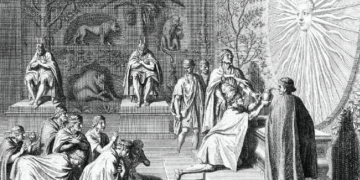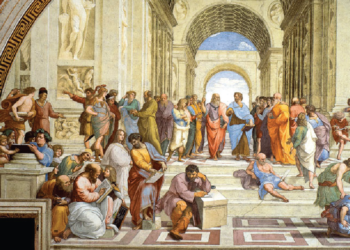Copenhagen Interpretation of Quantum Mechanics
1) What is Quantum mechanics?
Quantum mechanics is a branch of physics that deals with the behavior of matter and energy at the atomic and subatomic levels. It was developed in the early 20th century by a number of physicists, including Max Planck, Albert Einstein, Niels Bohr, Werner Heisenberg, and Erwin Schrödinger.
At its core, quantum mechanics is based on the principle of wave-particle duality, which states that particles such as electrons and photons exhibit both wave-like and particle-like behavior, depending on how they are observed. In other words, particles exist in a state of superposition, where they can be thought of as existing in multiple states or locations simultaneously, until they are observed or measured, at which point their wave function collapses into a single definite state.
One of the key aspects of quantum mechanics is the concept of uncertainty, which arises from the fact that the position and momentum of particles cannot be known with certainty at the same time. This is known as the Heisenberg uncertainty principle, which states that the more precisely the position of a particle is known, the less precisely its momentum can be known, and vice versa.
The Copenhagen interpretation of quantum mechanics is one of the most widely accepted interpretations of the theory, and was developed by Niels Bohr and Werner Heisenberg in the 1920s. According to this interpretation, the observer plays a crucial role in the measurement process, and the act of observation or measurement causes the wave function of a particle to collapse into a definite state.
In the Copenhagen interpretation, the behavior of particles is described by a probabilistic wave function, which determines the probability of a particle being in a certain state or location at a given time. When a measurement is made, the wave function collapses into a single definite state, with a probability determined by the wave function.
The Copenhagen interpretation has been the subject of much debate and criticism over the years, with some physicists arguing that it relies too heavily on the role of the observer and that it does not provide a complete picture of the behavior of particles. Other interpretations of quantum mechanics have been proposed, including the many-worlds interpretation and the pilot wave theory.
2) Quantum reality:
Quantum reality refers to the underlying nature of the universe as described by the principles of quantum mechanics. It is a reality that is very different from the classical reality we experience in our everyday lives. In the world of quantum reality, particles exist in a state of superposition, meaning they can exist in multiple states or locations simultaneously, until they are observed or measured, at which point their wave function collapses into a single definite state. This leads to the concept of quantum entanglement, where particles can become entangled, meaning their states are linked and changes to one particle will affect the other, no matter how far apart they are.
Quantum reality is characterized by uncertainty, as the position and momentum of particles cannot be known with certainty at the same time, due to the Heisenberg uncertainty principle. The behavior of particles is described by a probabilistic wave function, which determines the probability of a particle being in a certain state or location at a given time.
One of the most fascinating aspects of quantum reality is the phenomenon of quantum tunneling, where particles can pass through barriers that would be impossible to cross in classical physics. This has important implications for technologies such as quantum computing and quantum cryptography.
Quantum reality has also led to the development of new interpretations of quantum mechanics, such as the many-worlds interpretation and the pilot wave theory, which attempt to provide a more complete picture of the behavior of particles in quantum systems.
3) Einstein on Quantum Reality:
Albert Einstein was one of the most brilliant and influential scientists of the 20th century, and his work on quantum mechanics and the nature of reality is still highly debated and discussed today. Although he made significant contributions to the development of quantum theory, he was also highly critical of some of its fundamental principles and interpretations.
One of the most significant areas in which Einstein differed from the prevailing interpretation of quantum mechanics was in his view of quantum reality. In contrast to the popular Copenhagen interpretation, which emphasized the probabilistic nature of quantum mechanics and the role of measurement in collapsing the wave function, Einstein believed in a more deterministic and objective view of reality.Einstein famously stated that “God does not play dice with the universe,” reflecting his belief that there must be underlying physical laws and determinism at work in the quantum world. He was highly critical of the Copenhagen interpretation, which he saw as emphasizing the observer’s role in defining reality and the indeterminacy of the quantum world.
Instead, Einstein believed that there must be some hidden variables or underlying physical principles that could explain the seemingly random and probabilistic behavior of quantum particles. He worked with other physicists such as Boris Podolsky and Nathan Rosen to develop a thought experiment known as the EPR paradox, which aimed to show that the predictions of quantum mechanics were incomplete and that there must be some additional variables or principles at play.
The EPR paradox involved entangled particles, where the state of one particle would be determined by the state of another particle, regardless of the distance between them. Einstein, Podolsky, and Rosen argued that if two entangled particles were measured in such a way that their states were determined, then the measurement of one particle could instantaneously determine the state of the other particle, regardless of the distance between them. This would violate the principle of locality, which states that information cannot be transmitted faster than the speed of light.
The EPR paradox was an attempt to show that quantum mechanics was incomplete and that there must be some additional physical principles at work that could explain the behavior of entangled particles. However, subsequent experiments and developments in quantum mechanics have shown that the predictions of quantum mechanics are correct and that the behavior of entangled particles is indeed probabilistic and indeterminate.
Despite his criticisms of quantum mechanics, Einstein made significant contributions to the field, including the development of the theory of stimulated emission, which led to the development of the laser, and the discovery of the photoelectric effect, which helped to establish the wave-particle duality of light.
4) Neils Bohr on Quantum Reality:
Niels Bohr was a pioneering physicist who made significant contributions to our understanding of quantum mechanics. One of his most influential contributions was the development of the Copenhagen interpretation of quantum mechanics, which is still widely accepted today.The Copenhagen interpretation emphasizes the role of measurement in determining the state of a quantum particle. According to Bohr, a quantum particle exists in a superposition of all possible states until it is observed or measured, at which point the wave function collapses and the particle assumes a definite state. This concept of wave function collapse is a fundamental aspect of the Copenhagen interpretation.
However, Bohr’s interpretation of quantum reality differed from that of other prominent physicists, including Einstein. While Einstein believed in the underlying physical laws and determinism at work in the quantum world, Bohr emphasized the probabilistic and indeterminate nature of quantum mechanics. Bohr believed that the wave function represented a complete description of a quantum system and could not be further analyzed or broken down into more fundamental parts.
Bohr also emphasized the concept of complementarity in quantum mechanics. This concept states that certain physical phenomena are complementary and cannot be observed simultaneously. For example, the wave-particle duality of light and matter, which states that particles can exhibit both wave-like and particle-like behavior depending on the observation method, is a fundamental concept in the Copenhagen interpretation.
Bohr’s interpretation of quantum mechanics had a significant impact on our understanding of the nature of reality. His emphasis on complementarity and the role of measurement in determining the state of a quantum particle continue to shape our understanding of the quantum world today. However, Bohr’s interpretation has also been subject to criticism and debate. Some physicists have argued that the Copenhagen interpretation places too much emphasis on the role of the observer and measurement, and that there may be alternative interpretations of quantum mechanics that do not rely on these concepts.
5) Einstein vs Bohr:
Albert Einstein and Niels Bohr had different views on the interpretation of quantum mechanics, which led to a famous debate between the two physicists in the 1920s and 1930s. Einstein believed in a deterministic universe, where everything had a definite position and momentum, and that particles should have a definite reality independent of observation. He famously said, “God does not play dice with the universe” to express his belief that there was an underlying reality to the behavior of particles at the quantum level. Einstein’s view on the natureof reality led him to reject the Copenhagen interpretation of quantum mechanics, which asserts that particles do not have a definite position or momentum until they are observed.
Bohr, on the other hand, believed that the probabilistic nature of quantum mechanics was a fundamental aspect of reality at the quantum level. He argued that it was impossible to understand the behavior of particles without taking into account the observer and the measurement process. Bohr’s view led him to support the Copenhagen interpretation of quantum mechanics, which asserts that particles do not have a definite position or momentum until they are observed, at which point their wave function collapses into a single state.
The debate between Einstein and Bohr was not simply a scientific disagreement, but also a philosophical one. It raised questions about the nature of reality, the role of the observer in the scientific process, and the limitations of scientific knowledge. This debate was pivotal in shaping our current knowledge of the quantum world. The discussion concentrated on the interpretation of quantum mechanics and the importance of measurement and observation in determining a quantum particle’s state.
Einstein was critical of the Copenhagen interpretation, which was established in the 1920s by Bohr and other scientists. Einstein argued that there must be some underlying scientific principles at work to explain the behavior of entangled particles, which appeared to break classical physics laws. In 1935, Einstein famously suggested the EPR (Einstein-Podolsky-Rosen) paradox to question the Copenhagen interpretation. The paradox envisioned two entangled particles, A and B, separated by a great distance. If particle A is measured and found to be in a specific condition, particle B will quickly take the opposite state, even if they are light-years distant. Einstein contended that this meant that there must be some unobservable hidden variables at work that determined the state of the particles.
Bohr emphasized quantum mechanics’ probabilistic and indeterminate nature. He considered the wave function to be a full description of a quantum system that could not be further examined or broken down into more fundamental pieces. Bohr also stressed the concept of complementarity in quantum physics, which argues that certain physical phenomena are complementary and cannot be observed simultaneously.
In the end, neither Einstein nor Bohr was able to definitively prove their position, and the debate continues to this day. However, their contributions to the development of quantum mechanics and their differing views on the interpretation of the theory have had a profound impact on the field of physics and the way we understand the nature of reality.
6) Anti-realism in Quantum Mechanics:
Anti-realism is a philosophical position that rejects the notion of an objective reality that exists independently of human perception or observation. In the context of quantum mechanics, anti-realism refers to the idea that the properties of particles at the quantum level do not have a definite reality until they are observed or measured.
The anti-realist interpretation of quantum mechanics is based on the Copenhagen interpretation, which asserts that particles do not have a definite position or momentum until they are observed, at which point their wave function collapses into a single state. This means that particles exist in a superposition of states until they are observed, at which point they collapse into a single state.
The idea of anti-realism in quantum mechanics has been the subject of debate and controversy among physicists and philosophers for decades. Some argue that it is a necessary part of the theory, while others see it as a limitation of our understanding of the behavior of particles at the quantum level.
One of the main arguments in favor of anti-realism is that it is supported by experimental evidence. Quantum mechanics has been confirmed by numerous experiments, and the probabilistic nature of the theory has been verified through the statistical analysis of large numbers of measurements.
Another argument in favor of anti-realism is that it is consistent with the principles of relativity. The idea that particles do not have a definite position or momentum until they are observed is consistent with the idea that there is no privileged observer in the universe. In other words, the properties of particles depend on the observer and the measurement process, rather than on an objective reality that exists independently of human perception.
However, there are also arguments against anti-realism in quantum mechanics. One of the main criticisms is that it leads to a lack of predictability and causality in the behavior of particles. If particles do not have a definite reality until they are observed, it is difficult to predict their behavior or understand the underlying causes of their behavior.
Another criticism of anti-realism is that it raises questions about the nature of reality and the role of human perception in scientific knowledge. If reality depends on observation, then how can we know anything about the world that exists independently of our observation?












